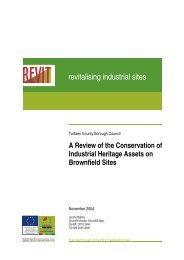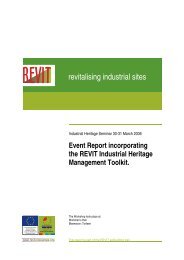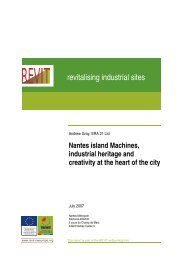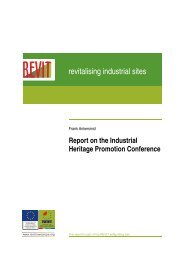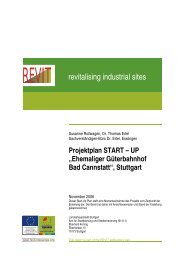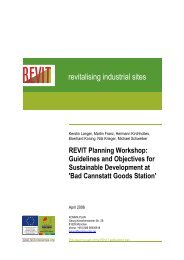REVIT Sustainable Evaluation Tool.pdf
REVIT Sustainable Evaluation Tool.pdf
REVIT Sustainable Evaluation Tool.pdf
Create successful ePaper yourself
Turn your PDF publications into a flip-book with our unique Google optimized e-Paper software.
<strong>Sustainable</strong> <strong>Evaluation</strong> for Brownfield Sites<br />
Brownfield sites generally have a bad press regarding their status within the realms of urban<br />
development. This is not without foundation. Brownfield sites are often associated with; high<br />
risks of development, including; contaminated land and ground water; structural problems to land<br />
and buildings, high costs of remediation and development; and a poor perception amongst local<br />
stakeholders. If this is not sufficient to quell enthusiasm for renewing Brownfield sites, then the<br />
length of time, planning issues, and funding opportunities for re-use, present further obstacles.<br />
This series of pessimistic outlooks can be viewed alternatively by a more optimistic approach.<br />
This is that Brownfield sites present opportunities to realise sustainable development<br />
improvements and thus they can have a positive impact on the environment, local or regional<br />
economy and the social capital of previously blighted areas.<br />
This positive approach however, requires credible improvements to be made over the long term,<br />
which can be quoted, verified and marketed with confidence. This in turn requires a method of<br />
establishing a sustainable development status baseline together with an evaluation system and a<br />
way of measuring improvements.<br />
Researching, developing and applying a common set of sustainable indicators and an evaluation<br />
process to the development of Brownfield sites has been one of the ambitions of the <strong>REVIT</strong><br />
project. Initial research reviewed the legal and institutional frameworks that set the context for<br />
sustainable development in each partner country, i.e. what are the key drivers and policy issues.<br />
The result of this research showed that it is not possible to develop a common set of sustainable<br />
development indicators and targets for Brownfield sites across the EU. The reason for this is that<br />
each Country and even regions within countries have distinct policies, legislation and approaches<br />
to sustainable development, which may have many common characteristics but also have unique<br />
requirements that cannot be universally applied.<br />
The <strong>REVIT</strong> project has thus developed a methodology that can apply sustainable development<br />
principals to individual sites, through an iterative and integrated approach, where both EU as well<br />
as local targets to improve the status of the environment, economic and social well being are<br />
continually assessed and addressed.<br />
<strong>Sustainable</strong> <strong>Evaluation</strong> Process<br />
The process of sustainability evaluation requires two main elements:<br />
o Sustainability objectives, against which project parameters are weighted and;<br />
o A methodology, which sets targets, measures and shows if, and or how sustainable<br />
development issues have been addressed within a project.<br />
The <strong>Sustainable</strong> <strong>Evaluation</strong> Process developed by the <strong>REVIT</strong> Project shown in fig 1. shows that<br />
at its apex three interconnected elements;- the site, its context and its vision.<br />
2



